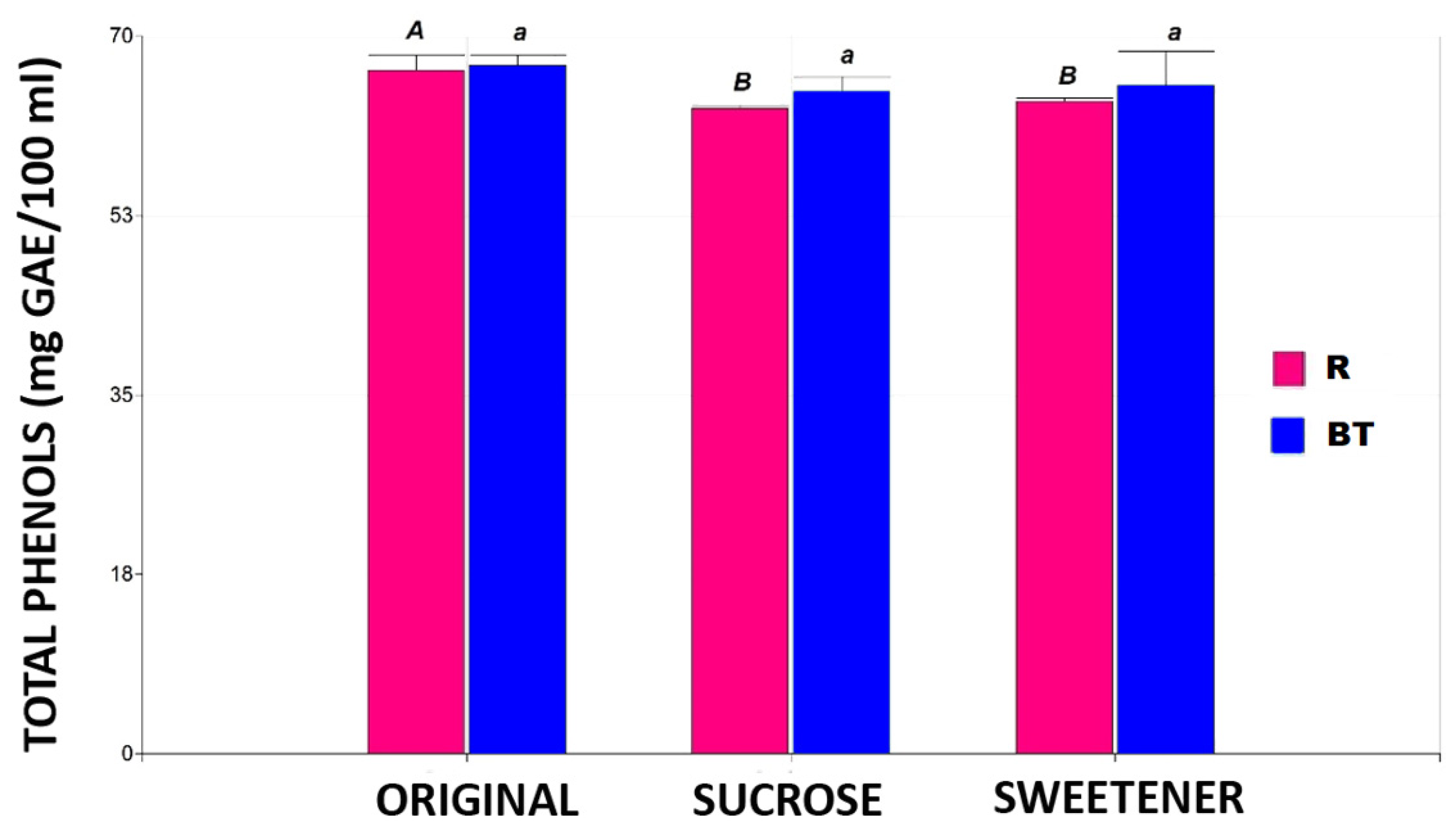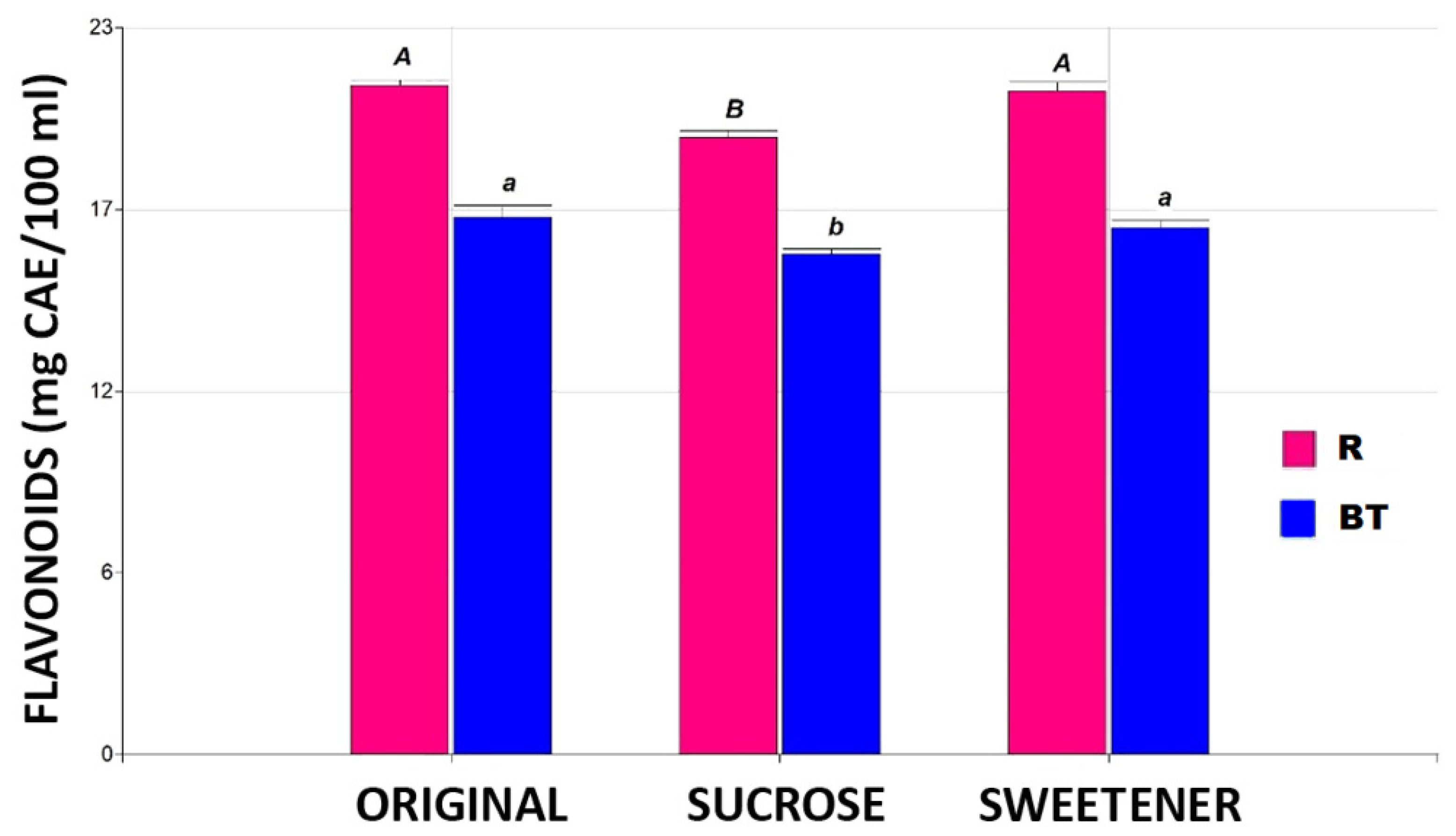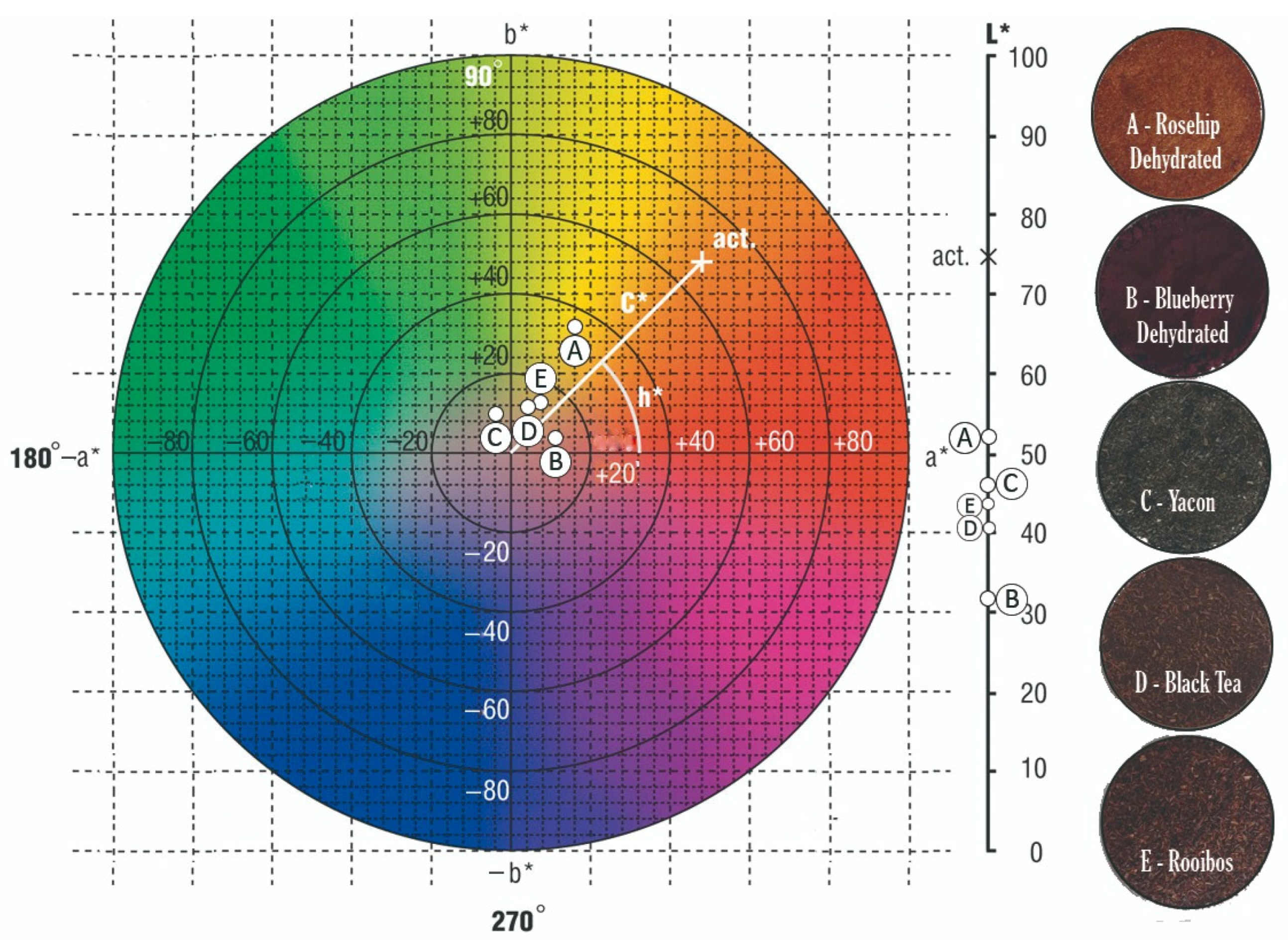An Evaluation of the Functional Potential of Beverages Made from Regional Plant Matrices †
Abstract
1. Introduction
2. Materials and Methods
2.1. Raw Materials
2.2. Dehydration
2.3. Preparation of Extracts
2.4. Addition of Sugar or Sweetener
2.5. Assessment of Total Phenols by Fast Blue (TPs)
2.6. Assessment of Flavonoid (Fv)
2.7. Assessment of Antioxidant Activity Index (AAI)
2.8. Assessment of Minerals
2.9. Assessment of Superficial Color
2.10. Statistical Analysis
3. Results and Discussion
4. Conclusions
Author Contributions
Funding
Institutional Review Board Statement
Informed Consent Statement
Data Availability Statement
Conflicts of Interest
References
- Romero-Cerecero, O.; Reyes-Morales, H.; Herrera-Arellano, A.; Lozoya-Legorreta, X.; Tortoriello, J. Acceptance of phytopharmaceuticals by doctors and patients in primary care clinics. Med. J. 2004, 42, 125–130. [Google Scholar]
- Cañigueral, S.; Vila, R. Principles of Phytotherapy. Medicinal Plants and Phytotherapy; General Council of Official Colleges of Pharmacists: Madrid, Spain, 2001; Volume 1, pp. 173–193. [Google Scholar]
- PubMed Central. Available online: https://www.ncbi.nlm.nih.gov/pubmed (accessed on 20 June 2024).
- Ballarín, M. Tea Time; Editorial LIBSA: Madrid, Spain, 2014. [Google Scholar]
- Bruzone, I. Fine Fruits in the Patagonian Mountain Valleys. Argent. Foods J. 2004, pp. 36–38. Available online: https://biblioteca.ucel.edu.ar/cgi-bin/koha/opac-detail.pl?biblionumber=48764 (accessed on 1 December 2024).
- Argentina Innovadora 2020; Ministerio de Ciencia, Tecnología e Innovación Productiva. Núcleo Socio-Productivo Estratégico. Procesamiento de Alimentos. Available online: https://www.argentina.gob.ar/sites/default/files/procesamiento-alimentos-doc.pdf (accessed on 19 February 2025).
- Ohaco Domínguez, E. Product Models to Optimize Convective Drying Equipment for Rosehip Fruits in Terms of Process Times and Final Product Quality. Ph.D. Thesis, National University of Bahía Blanca, Bahía Blanca, Argentina, 2012. [Google Scholar]
- Medina, M. Simple and rapid method for the analysis of phenolic compounds in beverages and grains. J. Agric. Food Chem. 2011, 59, 1565–1571. [Google Scholar] [CrossRef] [PubMed]
- Zhishen, J.; Mengcheng, T.; Jianming, W. The determination of flavonoid contents in mulberry and their scavenging effects on superoxide radicals. Food Chem. 1999, 64, 555–559. [Google Scholar] [CrossRef]
- Scherer, R.; Godoy, H. Antioxidant activity index (AAI) by the 2,2-diphenyl-1-picrylhydrazyl method. Food Chem. 2008, 112, 654–658. [Google Scholar] [CrossRef]
- American Public Health Association. Standard Methods for the Examination of Water and Wastewater, 18th ed.; APHA: Washington, DC, USA, 1992. [Google Scholar]
- Di Rienzo, J.A.; Casanoves, F.; Balzarini, M.G.; Gonzalez, L.; Tablada, M.; Robledo, C.W. InfoStat Versión 2020. Centro de Transferencia InfoStat, FCA, Universidad Nacional de Córdoba, Argentina. Available online: http://www.infostat.com.ar (accessed on 1 December 2024).
- Pietta, P. Flavonoids as antioxidants. J. Nat. Prod. 1999, 63, 1035–1042. [Google Scholar] [CrossRef] [PubMed]
- Middleton, E.; Kandaswami, C. The impact of plant flavonoids on mammalian biology: Implications for immunity, inflammation, and cancer. In The Flavonoids; Harborne, J.B., Ed.; Chapman and Hall: London, UK, 1994; pp. 619–652. [Google Scholar]
- Vera Tudela, R. Iced Infusions as Alternative Drinks in the National Market. Bachelor’s Thesis, University of Piura, Piura, Peru, 2003. [Google Scholar]
- World Health Organization (WHO). Guideline: Potassium Intake for Adults and Children; WHO: Geneva, Switzerland, 2012. [Google Scholar]
- Miñana, V. Oral rehydration with refreshing beverages: Risk of iatrogenic complications. Acta Pediatr. Esp. 2001, 60, 205–210. [Google Scholar]
- Argentine Food Code. Chapter XI. Article 888. Available online: https://www.argentina.gob.ar/sites/default/files/capitulo_xi_vegetales_actualiz_2024-8.pdf (accessed on 19 February 2025).
- Sharma, V.; Kumar, H.; Rao, L.J. Influence of milk and sugar on antioxidant potential of black tea. Food Res. Int. 2008, 41, 124–129. [Google Scholar] [CrossRef]
- Su, Y.; Leung, L.; Huang, Y.; Chen, Z. Stability of tea theaflavins and catechins. Food Chem. 2003, 83, 189–195. [Google Scholar]
- Chen, Z.; Zhou, B.; Yang, L.; Wu, L.; Liu, Z. Antioxidant activity of green tea polyphenols against lipid peroxidation initiated by lipid-soluble radicals in micelles. J. Chem. Soc. Perkin Trans. 2001, 2, 1835–1839. [Google Scholar] [CrossRef]
- Das, A.; Gantait, S.; Mandal, N. Micropropagation of an elite medicinal plant: Stevia rebaudiana Bert. Int. J. Agric. Res. 2011, 6, 40–48. [Google Scholar] [CrossRef]
- Santamaría, Á. Stevia and Other Healthy Sweeteners in the Formulation of Functional Candies: Technological and Quality Implications. Ph.D. Thesis, Polytechnic University of Valencia, Valencia, Spain, 2014. [Google Scholar]
- Shalaby, E.; Mahmoud, G.; Shanab, S.M. Suggested mechanism for the effect of sweeteners on radical scavenging activity of phenolic compounds in black and green tea. Front. Life Sci. 2016, 9, 241–251. [Google Scholar] [CrossRef]
- Goyal, S.; Samsher, G.; Goyal, R. Stevia (Stevia rebaudiana) a bio-sweetener: A review. Int. J. Food Sci. Nutr. 2010, 61, 1–10. [Google Scholar] [CrossRef] [PubMed]
- Criado, M.; Barba, F.; Frígola, A.; Rodrigo, D. Effect of Stevia rebaudiana on oxidative enzyme activity and its correlation with antioxidant capacity and bioactive compounds. Food Bioprocess Technol. 2014, 7, 1518–1525. [Google Scholar] [CrossRef]
- Morales Orjuela, L. Antioxidant and Antimicrobial Activity of the Plant Extract Obtained from a Commercial Cultivation of Stevia Rebaudiana Located in Olaya (Antioquia). Bachelor’s Thesis, University of Tolima, Ibagué, Colombia, 2017. [Google Scholar]






| Extracts | RMD (g) | BD (g) | Y (g) | BT (g) | R (g) |
|---|---|---|---|---|---|
| Tisane BT | 0.6 | 0.6 | 0.6 | 1.2 | --- |
| Tisane R | 0.6 | 0.6 | 0.6 | --- | 1.2 |
| Extracts | TPs | Fvs | AAI | Na | K |
|---|---|---|---|---|---|
| Tisane BN | 67 ± 4 a | 17 ± 1 b | 4.32 ± 0.05 a | 4.4 ± 0.1 b | 153 ± 2 b |
| Tisane R | 67 ± 3 a | 21 ± 0 a | 4.39 ± 0.10 a | 22.8 ± 0.1 a | 159 ± 1 a |
| Sample | L* | a* | b* | Hue | Chroma |
|---|---|---|---|---|---|
| RMD | 53.16 ± 3.14 a | 16.20 ± 0.70 a | 26.60 ± 2.29 a | 58.52 ± 3.20 d | 31.19 ± 1.68 a |
| BD | 31.59 ± 0.31 e | 11.60 ± 0.42 b | 2.59 ± 0.15 d | 12.61 ± 0.75 e | 11.89 ± 0.42 c |
| Y | 46.93 ± 0.48 b | −1.76 ± 0.26 e | 9.90 ± 0.39 c | 100.11 ± 1.60 a | 10.06 ± 0.37 d |
| BT | 41.87 ± 0.42 d | 4.12 ± 0.21 d | 10.83 ± 0.37 c | 69.16 ± 0.65 b | 11.59 ± 0.40 c |
| R | 44.10 ± 1.24 c | 6.92 ± 0.37 c | 12.38 ± 0.92 b | 60.75 ± 1.63 c | 14.19 ± 0.90 b |
| Sample | L* | a* | b* | Hue | Chroma |
|---|---|---|---|---|---|
| Infusion BT | 16.26 ± 4.02 A | 0.66 ± 0.14 b | 2.33 ± 0.08 B* | 74.19 ± 3.49 a* | 2.42 ± 0.05 b’ |
| Infusion R | 18.05 ± 0.10 A | 1.32 ± 0.04 a | 2.82 ± 0.15 A* | 64.80 ± 1.58 b* | 3.11 ± 0.13 a’ |
Disclaimer/Publisher’s Note: The statements, opinions and data contained in all publications are solely those of the individual author(s) and contributor(s) and not of MDPI and/or the editor(s). MDPI and/or the editor(s) disclaim responsibility for any injury to people or property resulting from any ideas, methods, instructions or products referred to in the content. |
© 2025 by the authors. Licensee MDPI, Basel, Switzerland. This article is an open access article distributed under the terms and conditions of the Creative Commons Attribution (CC BY) license (https://creativecommons.org/licenses/by/4.0/).
Share and Cite
Paulino, C.A.; Namor, F.C. An Evaluation of the Functional Potential of Beverages Made from Regional Plant Matrices. Biol. Life Sci. Forum 2024, 40, 39. https://doi.org/10.3390/blsf2024040039
Paulino CA, Namor FC. An Evaluation of the Functional Potential of Beverages Made from Regional Plant Matrices. Biology and Life Sciences Forum. 2024; 40(1):39. https://doi.org/10.3390/blsf2024040039
Chicago/Turabian StylePaulino, Carolina Antonella, and Facundo Carlos Namor. 2024. "An Evaluation of the Functional Potential of Beverages Made from Regional Plant Matrices" Biology and Life Sciences Forum 40, no. 1: 39. https://doi.org/10.3390/blsf2024040039
APA StylePaulino, C. A., & Namor, F. C. (2024). An Evaluation of the Functional Potential of Beverages Made from Regional Plant Matrices. Biology and Life Sciences Forum, 40(1), 39. https://doi.org/10.3390/blsf2024040039






